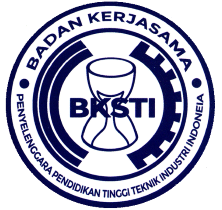Analisis Beban Kerja Dan Jumlah Tenaga Kerja Pada Bagian Bahan Baku Menggunakan Metode Workload Analysis
DOI:
https://doi.org/10.52759/inventory.v1i1.21Keywords:
Workload, Workload AnalisysAbstract
This research was conducted at PT. XYZ in the garden section, a company engaged in the forestry sector of industrial plants and products that produce HVS paper (such as paper one, otc), paperboard, kiky books, tissue (teas). PT.XYZ manages raw materials that are not in accordance with the target, the purpose of this study is to determine the amount of workload and the number of workers in the garden section at PT. XYZ. To collect the data needed in this study, data collection techniques were used through direct observation of the object under study, interviews and various other reference sources. Data analysis using the Workload Analysis method. From the results of calculations using the method, workload is one aspect that must be considered by every company, and workload must be considered for a worker to get harmony and high work productivity. By using the Workload Analysis method and to find out how much the optimal number of workers is in the raw material section. After analyzing the data using this analysis, it can be obtained that the average workload on the raw material section is 184.39%, which means that the workload is excessive. In order for the workload of each workforce in the garden to be optimal, it is advisable to increase the workload with an average workload of 92.19% so that effectiveness can be achieved.
Downloads
References
Arif, R. Analisa Beban Kerja dan Jumlah Tenaga Kerja Yang Optimal Pada Bagian Produksi Dengan Pendekatan Metode Work Load Analysis (Studi Kasus: PT. Surabaya Perdana Rotopack). Jawa Timur: Jurnal Teknik Industri Universitas Pembangunan Nasional “Veteran.2014.
Astianto, A. dan Suprihhadi, H. Pengaruh Stres Kerja dan Beban Kerja Terhadap Kinerja Karyawan PDAM Surabaya. Jurnal Ilmu & Riset Manajemen Vol. 3 No. 7, pp 1 – 8. 2014
Lituhayu, Rizaini. Mangkuprawiru, Tb Sjafri. Dhewi, Ratih Maria. Analisa Beban Kerja dan Kinerja Karyawan (Studi Kasus Pada Head Office PT. Lerindo Internasional Jakarta). Sarjana, Skripsi. Institut Pertanian Bogor.2008.
Prabowo, A., dkk. Analisa Beban Kerja dan Penentuan Tenaga Kerja Optimal dengan Pendekatan Work Load Analysis (WLA). Jurnal Teknik Industri Vol. 5 No. 1, pp 3. 2017.
Rafian, Ade Muhammad dan Ahmad Muhsin. Analisis Beban Kerja Mekanik Pada Departemen Plant dengan Metode Work Sampling, Jurnal OPSI, Vol 10 No 1 Juni 2017, hlm 35-42, dapat diakses di http://jurnal.upnyk.ac.id/index.php/op si/article/download/2165/1905. 2017.
Wakhinuddin. Pengertian Evaluasi, Beban Kerja, Optimalisasi. Webblog.com. Http///www.wakhinuddin.weblog//pengertianevaluasibabankerjaoptimalisasi.com (diakses 8 desember 2017).
Wakui, Tadaaki. Study On work Load Of Matron Under shift A Special Nursing Home For The Elderly, Journal of Industrial Health, www.niih.go.jp/en/indu_hel/2000pdf/IH38_36.pdf.2010.
Wibawa, R. P. N., Sugiono, S., & Efranto, R. Y. Analisis Beban Kerja Dengan Metode Workload Analysis Sebagai Pertimbangan Pemberian Insentif Pekerja (Studi Kasus di Bidang PPIP PT Barata Indonesia (Persero) Gresik). Jurnal Rekayasa Dan Manajemen Sistem Industri, 2 (3), p672-683. 2014
Wignjosoebroto, S. Ergonomi studi gerak dan waktu. Surabaya: Guna Widya, 2003, pp, 283.




